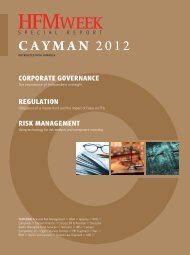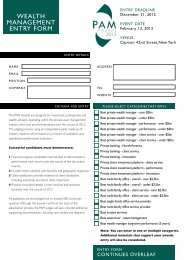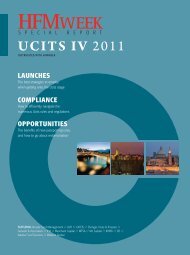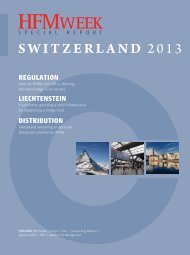US EAST COAST 2012 - HFMWeek
US EAST COAST 2012 - HFMWeek
US EAST COAST 2012 - HFMWeek
You also want an ePaper? Increase the reach of your titles
YUMPU automatically turns print PDFs into web optimized ePapers that Google loves.
<strong>US</strong> EAS T COAS T <strong>2012</strong><br />
FUND SERVICES<br />
ing well known is not in itself sufficient for an allocator to<br />
‘check the box’ these days. Even if the firm is well known,<br />
lacking the expertise in the specific fund strategy could be<br />
equally harmful. A law firm that focuses on fund creation<br />
of fairly standard long/short equity funds may not be the<br />
best firm to engage with if the fund is going to be heavily<br />
investing in real estate.<br />
One area of focus during the due diligence process that<br />
has been consistent over the past few years is the mechanics<br />
of back office support. Allocators want to find a robust<br />
process in place, which has appropriate checks and balances.<br />
The relationship between the manager, administrator,<br />
and prime broker or custodian, and how the information<br />
is flowing is a key point of interest for the allocator. During<br />
the due diligence process, the investor wants to ensure<br />
there is a proper reconciliation between the broker’s<br />
execution of trades and what the manager<br />
thinks should have been executed. There tends to<br />
be a preference among allocators to have a third<br />
party (the administrator) conduct that reconciliation.<br />
In the past, or currently with much smaller<br />
funds, the chief financial officer (CFO) may conduct<br />
that reconciliation and the administrator may<br />
not be given access to the trade orders, instead<br />
only receiving trade information directly from the<br />
prime broker. This kind of setup may have been<br />
acceptable several years ago and may be suitable<br />
for small non-institutional funds today, but as<br />
those funds grow, the dynamics of this process<br />
need to change.<br />
In a similar vein, it is important for the manager<br />
to mirror or shadow the books of the administrator.<br />
Blindly accepting the NAV issued by the<br />
service provider is, for obvious reasons, frowned<br />
upon. The degree of the shadow accounting can<br />
greatly vary. Some managers choose to engage<br />
a second back office service provider to shadow<br />
the primary administrator. Other managers have<br />
teams in place that perform this function<br />
internally. Whatever method is selected, the<br />
outcome allocators want to see is a robust<br />
process where the manager can accurately<br />
and timely detect errors. A cursory review of<br />
the NAV by the CFO will not likely be found<br />
sufficient during the due diligence process.<br />
Allocators will look for the administrator<br />
to have a dedicated pricing team as well as a<br />
current SSAE 16 (formally SAS 70), which in<br />
short, attests the controls of the organisation<br />
are sufficient. These are easy ‘check the box’<br />
qualifications the administrator should bear,<br />
which helps reduce back office questions during<br />
the due diligence process.<br />
Avoiding conflicts of interest and maintaining<br />
service provider independence is<br />
extremely important to allocators as well.<br />
Some examples of independence issues can<br />
be as blatant as a manager who makes a direct<br />
investment in their administrator, to something<br />
as seemingly harmless as a familial connection<br />
to the engaged accounting firm. It is<br />
critical that these conflicts be addressed in a<br />
IT IS IMPORTANT FOR THE<br />
MANAGER TO MIRROR<br />
OR SHADOW THE BOOKS<br />
OF THE ADMINISTRATOR.<br />
BLINDLY ACCEPTING THE<br />
NAV ISSUED BY THE<br />
SERVICE PROVIDER IS,<br />
FOR OBVIO<strong>US</strong> REASONS,<br />
FROWNED UPON<br />
”<br />
reasonable manner. It may not be necessary to find a new<br />
accounting firm, but a simple solution where the family<br />
member avoids all assurance/tax work on the manager’s<br />
products could be an acceptable solution.<br />
Counterparty risk is a hot topic as well. With investment<br />
bank collapses like Lehman Brothers and continued<br />
uncertainty in the financial health of various firms around<br />
the globe, spreading the fund’s assets across multiple<br />
prime brokers/custodians is a sought after approach to<br />
mitigate this risk. Allocators may be uncomfortable with<br />
seeing all the fund’s eggs in one basket. Although it is appealing<br />
to some managers to concentrate assets in order<br />
to get better financing terms, this economic payoff is usually<br />
viewed as shortsighted by allocators.<br />
THE INVESTMENT MANAGEMENT COMPANY<br />
IS A B<strong>US</strong>INESS<br />
The last point that tends to be missed by many<br />
managers is that the investment management<br />
company is a business that needs to be sustainable.<br />
Allocators want to ensure that the revenue raised<br />
through management fees can adequately cover<br />
daily company expenses including infrastructure,<br />
costs, and personnel. If the financials of the business<br />
are unhealthy, it can almost be a guarantee<br />
that institutional investors will have a hard time<br />
committing to an investment in any of the products.<br />
In summary, performance is not the only<br />
factor that will attract institutional money. The<br />
manager needs to have a concise and consistent<br />
message backed by a sound infrastructure with<br />
quality service providers. Both the investment<br />
strategy and the management company need to<br />
be sustainable entities that can be viewed from an<br />
allocator’s perspective as a long term investment.<br />
Following these principles will allow a manager to<br />
attract and retain institutional investment from a<br />
due diligence perspective. n<br />
32 HFMWEEK.COM











